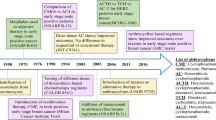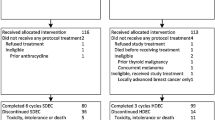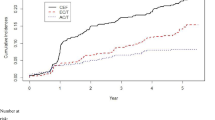Abstract
The isolation and clinical use of anthracyclines and taxanes were major breakthroughs in cancer chemotherapy. Their use has lead to cures and palliation of patients with diverse cancer types, notably breast cancer, malignant lymphomas, ovarian cancer and acute leukaemia. More recently there have been efforts to exclude anthracyclines from early breast cancer protocols because of toxicity and also hypothesized lack of efficacy in non-Her2/Neu amplified, and by the extrapolation of non-topoisomerase II-α co-amplified tumours. We studied the records of 212 patients treated in three private oncology facilities in Nairobi with anthracycline-or taxane-containing protocols. In total, 225 treatment protocols were analysed since some patients were treated with more than one protocol. Breast carcinoma accounted for 61.8% of the cases, followed by non-Hodgkin’s lymphomas, which accounted for 16.5%. Doxorubicin was used in 58.2% of the protocols, paclitaxel in 7.6% and docetaxel in 11.1%. Clinical cardiac toxicity was recorded in 4.6% of the protocols containing doxorubicin, none with paclitaxel and 12% with docetaxel. Neurotoxicity was recorded in 2 (1.5%) of the protocols with doxorubicin, 5 (29.4%) with paclitaxel and 4 (16%) with docetaxel. Fluid retention was not experienced with doxorubicin, but in 1 (5.9%) with paclitaxel and in 5 (20%) with docetaxel. Toxicity was not recorded in 93.9% of protocols with doxorubicin, 64.7% with paclitaxel and 52% with docetaxel. These differences were highly significant (P < 0.001). We conclude that non-haematopoietic toxicity of anthracyclines is more favourable than that of taxanes.
Résumé
L’isolement et l’utilisation clinique des anthracyclines et des taxanes ont été des percées majeures en chimiothérapie anticancéreuse. Ces composés ont permis la guérison et les soins palliatifs de patients atteints de divers types de cancers, notamment le cancer du sein, les lymphomes malins, le cancer de l’ovaire, les leucémies aiguës. Plus récemment, on a tenté d’exclure les anthracyclines au début des protocoles relatifs au cancer du sein pour des raisons de toxicité, et aussi d’une hypothétique inefficacité dans les tumeurs non Her2/Neu — par extrapolation des tumeurs coamplifiées non topo-isomérase II-α. Nous avons étudié les dossiers de 212 patients traités dans trois centres anticancéreux privés à Nairobi par des protocoles à base d’anthracyclines ou de taxanes. Au total, 225 protocoles thérapeutiques ont été analysés, car certains patients ont reçu plus d’un protocole. Le cancer du sein représentait 61,8 % des cas, suivi des lymphomes non hodgkiniens (16,5 % des cas). La doxorubicine a été utilisée dans 58,2 % des protocoles, le paclitaxel dans 7,6 % et le docétaxel dans 11,1 %. Une toxicité cardiaque clinique a été enregistrée dans 4,6 % des protocoles contenant la doxorubicine, aucun avec le paclitaxel et 12 % avec le docétaxel. Une neurotoxicité a été enregistrée dans deux protocoles (1,5 %) avec la doxorubicine, cinq (29,4 %) avec le paclitaxel et quatre (16 %) avec le docétaxel. Une rétention hydrique a été enregistrée dans un protocole (5,9 %) avec le paclitaxel et cinq (20 %) avec le docétaxel, mais dans aucun avec la doxorubicine. Aucune toxicité n’a été observée dans 93,9 % des protocoles avec la doxorubicine, 64,7 % avec le paclitaxel et 52 % avec le docétaxel. Ces différences étaient hautement significatives (p < 0,001). Nous en concluons que la toxicité non hématologique des anthracyclines est plus favorable que celle des taxanes.
Similar content being viewed by others
References
Tewey KM, Rowe TC, Young I, et al (1984) Adriamycin-induced DNA damage mediated by mammalian DNA topoisomerase II. Science 226:466–468
von Hoff DD, Layard MW, Basa P, et al (1979) Risk factors for doxorubicin-induced congestive heart failure. Ann Intern Med 91:710–717
Wojtacki J, Lewicka-Nowack E, Lesniewski-Kmak K (2000) Anthracycline-induced cardiotoxicity: clinical course, risk factors, pathogenesis, detection and prevention: review of the literature. Med Sci Monit 6:411–420
Steinherz LJ, Steinherz PG, Tan CT, et al (1991) Cardiac toxicity 4 to 20 years after completing anthracycline therapy. JAMA 266:1672–1677
Rowinsky EK, Cazenave LA, Donehower RC (1990) Taxol: a novel investigational antineoplastic agent. J Natl Cancer Inst 82:1247–1259
Rowinsky EK, Donehower RC (1995) Drug therapy: paclitaxel (taxol). N Engl J Med 332:1004–1014
Henderson IC, Berry D, Demetri G, et al (2003) Improved outcomes from adding sequential paclitaxel but not escalating doxorubicin dose in an adjuvant chemotherapy regimen for patients with node-positive primary breast cancer. J Clin Oncol 21:976–983
Cortes JE, Pazdur R (1995) Docetaxel. J Clin Oncol 13:2643–2655
Sparano JA (2000) Taxanes for breast cancer: an evidence-based review of randomized phase II and phase III trials. Clin Breast Cancer 1:32–37
Schiff PB, Fant J, Horwitz SB (1979) Promotion of microtubule assembly in vitro by taxol. Nature 277:665–667
Manfredi JJ, Parness J, Horwitz SB (1982) Taxol binds to cellular microtubules. J Cell Biol 94:688–696
Caplow M, Shanks J, Ruhlen R (1994) How taxol modulates microtubule disassembly. J Biol Chem 269:23399–23402
Lesser GJ, Grossman SA, Eller S, Rowinsky EK (1994) The neural extraneural distribution of systemically administered (3H) paclitaxel in rats: a quantitative autoradiographic study. Cancer Chemother Pharmacol 34:173
Garrison JA, McCune JS, Livingston RB (2003) Myalgias and arthralgias associated with paclitaxel. Oncology 17(2):271–277
Weiss R, Donehower RC, Wiernik PH, et al (1990) Hypersensitivity reactions from taxol. J Clin Oncol 8:1263–1268
Peerebom D, Donehower RC, Eisenhauer EA, et al (1993) Successful treatment with taxol after major hypersensitivity reactions. J Clin Oncol 11:885–890
Rowinsky EK, Chaundhry V, Cornblath DR, Donehower RC (1993) The neurotoxicity of taxol. J Natl Cancer Inst Monogr 15:107–115
Chaundhry V, Rowinsky EK, Sartorius SE, et al(1994) Peripheral neuropathy from taxol and cisplatin combination chemotherapy: clinical and electrophysiological studies. Ann Neurol 35:490
Cortes JE, Pazdur R (1995) Docetaxel. J Clin Oncol 13:2643–2655
Schrivers D, Wanders J, Dirix L, et al (1993) Coping with toxicities of docetaxel (taxotere). Ann Oncol 4:610–611
Semb KA, Aamdal S, Oian P (1998) Capillary protein leak syndrome appears to explain fluid retention in cancer patients who receive docetaxel treatment. J Clin Oncol 16:3426–3432
Wilson WH, Berg S. Bryant G, et al (1994) Paclitaxel in doxorubicin-refractory or mitoxantrone-refractory breast cancer: a phase I/II trial of 96-hour infusion. J Clin Oncol 12:1621–1629
Gennari A, Sormani MP, Pronzato P, et al (2008) Her2 status and efficacy of adjuvant anthracyclines in early breast cancer: a pooled analysis of randomized trials. J Natl Cancer Inst 100:14–20
Early Breast Cancer Trialists Collaborative Group (EBCTCG) (2005) Effects of chemotherapy and hormonal therapy for early breast cancer on recurrence and 15-year survival: An overview of the randomised trials. Lancet 365:1687–1717
Peto R (December 13, 2007) Plenary lecture: San Antonio Breast Cancer Conference:San Antonio, Tx. http://www.sabcs.org/EnduringMaterials/Index.asp#webcast/
National Cancer Institute (NCI) (2006) Common toxicity criteria (CTC) version 3
Mutuma GZ, Rugut-Korir A (2006) Cancer incidence report — Nairobi: 2000–2002. Kenya Medical Research Institute
Pegram MD, Finn RS, Arzoo K, et al (1997) The effect of Her2/neu overexpression on chemotherapeutic drug sensitivity in human breast and ovarian cancer cells. Oncogene 15:537–547
Markman M, Kennedy A, Webser K, et al (1998) Paclitaxel administration to gynaecologic cancer patients with major cardiac risk factors. J Clin Oncol 16:3483–3485
Rowinsky EK, McGuire WP, Guarnieri T, et al (1991) Cardiac disturbances during administration of taxol. J Clin Oncol 9:1704–1712
Gianni L, Monzone E, Capri G, et al (1995) Paclitaxel by 3-hour infusion in combination with bolus doxorubicin in women with untreated metastatic breast cancer: high antitumour efficacy and cardiac effects in a dose-finding and sequence-finding study. J Clin Oncol 13:2688–2699
Author information
Authors and Affiliations
Corresponding author
Additional information
The abstract of this paper was presented in oral form at the 2009 AORTIC conference, Dar-Es-Salaam. Le résumé de cet article a été présenté oralement lors de la conférence de l’OAREC/AORTIC en 2009 à Dar-Es-Salaam.
About this article
Cite this article
Othieno Abinya, N.A., Kiarie, G.W., Musibi, A.M. et al. Non-haematopoietic toxicity of anthracylines is more favourable than that of taxanes: experience from Nairobi. J Afr Cancer 4, 3–8 (2012). https://doi.org/10.1007/s12558-011-0184-7
Revised:
Accepted:
Published:
Issue Date:
DOI: https://doi.org/10.1007/s12558-011-0184-7




